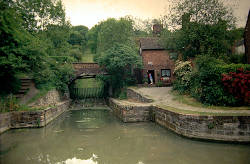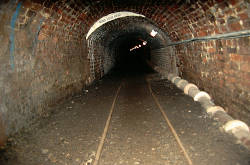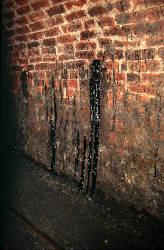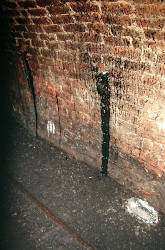Tar Tunnel
Ironbridge
Useful Information


| Location: |
High St, Telford TF8 7HT.
(52.620204, -2.453013) |
| Open: |
19-JUL to 05-SEP Sun 11, 12:30, 14, 15:30. [2021] |
| Fee: |
Tar Tunnel only:
Adults GBP 3, Children GBP 2, Seniors (60+) GBP 3. Ironbridge Passport: Adults GBP 29, Children GBP 19, Student GBP 19, Family (2+4) GBP 76, Family (1+4) GBP 47. Includes all sights of Ironbridge for one year. [2021] |
| Classification: |
 Crude Oil Crude Oil
|
| Light: |
 Electric Light Electric Light
|
| Dimension: | L=950 m |
| Guided tours: | guided with china museum |
| Photography: | allowed |
| Accessibility: | yes |
| Bibliography: |
I.J. Brown, B. Trinder (1972):
The Coalport Tar Tunnel,
Ironbridge: Ironbridge Museum and Shropshire Mining Club, 1972.
I.J. Brown, B. Trinder (1973): The Tar Tunnel, Ironbridge: Ironbridge Gorge Museum Trust, 1973. I.J. Brown (1977): The Tar Tunnel as a Public Show Mine, Journal of the Shropshire Mining Club, (1977), pp.1-3. Jonathan Craig, Francesco Gerali, Fiona MacAulay, Rasoul Sorkhabi (2018): The history of the European oil and gas industry - Introduction, Geological Society London Special Publications 465(1):SP465.23 10.1144/SP465.23 researchgate |
| Address: |
Ironbridge Gorge Museum Trust, High St, Telford TF8 7HT, Tel: +44-1952-433-424.
E-mail: Blists Hill Victorian Town, Legges Way, Telford TF7 5UD, Tel: +44-1952-433424. |
| As far as we know this information was accurate when it was published (see years in brackets), but may have changed since then. Please check rates and details directly with the companies in question if you need more recent info. |
|
History
| OCT-1786 | miners began to drive a tunnel into the side of the Severn Gorge under the direction of the ironmaster William Reynolds. |
| 1792 | Construction of the Shropshire Canal completed. |
| 1793 | Hay Inclined Plane begins operation. |
| JUN-1796 | explored by the geologist Charles Hatchett who recorded that the tunnel had a total length of 1,040 yards. |
| 1840s | tar dried up altogether. |
| 1847 | house built over the entrance of the abandoned tunnel, since then is reached through the cellar. |
| 1850 | tunnel lining repaired. |
| 1894 | Hay Inclined Plane closed. |
| 1960s | tunnel ’rediscovered’, stabilised and a section of it opened for visitors by the IGMT. |
| 1986 | inscribed on the UNESCO World Heritage List. |
Geology
At first 4,500 gallons of bitumen a week, and for several years over 1,000 gallons were collected. by the 1820’s this reduced to only 10 barrels a year.
Description


The Tar Tunnel lies on the north bank of the River Severn at Coalport, some kilometers east from Ironbridge. The site is named Tar Tunnel, which gives the impression that there is only this tar mine. But actually the site is a combination of several important transport infrastructure sites. There is the Hay Inclined Plane left of the tunnel, and the Coalport wharf right in front of the tunnel. The short section of the Shropshire Canal from the base of the Hay Inclined Plane to the junction with the River Severn is generally called the Coalport Canal. Its rather obvious that this tunnel was actually built as a part of this transport infrastructure. It was intended as a canal tunnel which could extend the canal system of the Shropshire Canal.
It was driven with the intention of assisting in the transportation of coal from the Blists Hill Pits. This plan was proposed by William Reynolds (1758–1803), an ironmaster and a partner in the ironworks in Coalbrookdale. Blists Hill is located only a kilometer to the north, but unfortunately at a much higher elevation. Today the site with its remaining furnaces, miners cottages and other historic sites is known as Blists Hill Victorian Town. The coal was mined underground, hauled to the surface by headframes, transported 800m to the Hay Inclined Plane, then lowered again to the river. It would have been much easier to bring the coal to the "lower exit" of the mine with a direct connection to the canal. Or in other words the canal could have lead into the coal mine, the coal would have been loaded on ships underground and then transported to the furnaces. An ingenious transport route that would have elegantly circumvented various problems. Especially the 70 m difference in altitude from the valley to the mine, and the repeated reloading of the coal by hand.
The Shropshire Canal was built to supply coal, ore and limestone to the industrial region of east Shropshire. It connects to the Donnington Wood Canal, the Newport Canal, the Wombridge Canal, the Ketley Canal and the Shrewsbury Canal. The canal system was used to transport the coal, and it is really impressing, what enormous funiculars were necessary to transport the ships from the hilltop down to the canal. They were named inclined plane in this context. Such an inclined plane connected the lower and upper part of the canal with railroad tracks. A section of the canal called caisson, a water-filled tank, was moving up and down this tracks connecting the two canals. A boat would enter the caisson, a double lock closed the canal and the caisson. Then the caisson moves up or down on the railroad tracks and connects with the other canal. The locks of caisson and canal are opened and the boat continues its travel. Like always the funicular works much better if there are two caissons connected by a rope. Then the weight of the two is in equilibrium and you only have to overcome the friction.
An inclined plane replaces a flight of canal locks, but it is quicker and wastes less water. On the other hand is more costly to install and operate. The Hay Inclined Plane had a height of 63 m. But today only the bare plane remains, even the railroad tracks were removed, then replaced during the reconstruction in 1963. But you can see a much shorter reconstruction at the Blists Hill Victorian Town only 1 km to the north, which actually works.
The Tar Tunnel was started in OCT-1786, when miners began to drive a tunnel into the side of the Severn Gorge under the direction of the ironmaster William Reynolds. But the drivage crossed a layer of natural bitumen and the "tar" in this layer formed a gushing spring, only 300 m from the entrance, flowing into the tunnel. They soon realized that this tar was valuable as itself. The bitumen was diverted into a stream and conveyed alongside the tunnel to the entrance where it was processed and sold. At the time the main commercial use was to treat and weatherproof ropes and caulk wooden ships. Small amounts were processed and bottled as Betton’s British Oil, a panacea remedy for rheumatism and scurvy. In other words, snake oil. Later other uses were found.
After some years of an impressive flow of tar, the spring run dry. The tar was still pumped for many years with declining flow rate until the tunnel was closed in 18??. The tar tunnel was a great curiosity in the 18th century, the Victorian times. And it was quite exceptional, as there were only very few oil mines worldwide.
And the original idea of extracting coal from the coal mine was also realized. The tunnel never became a canal tunnel, but after the first blowout or gusher the flow subsided and it was possible to divert it and convey it alongside the tunnel to the entrance. This effect, a result of the crude oil being under pressure, became later well known from oil wells. The tunnel was continued and by 1796 it reached the coal mines and a total length of 1,040 yards. By 1801, coal was transported from the mines through the tunnel. It was carried along the canal to the warehouse and wharves adjacent to Preen’s Eddy bridge and then to waiting boats on the river.
The Tar Tunnel is today part of Ironbridge Gorge Museum, which manages 10 historic sites elated to the early industrial revolution. This includes the Hay Inclined Plane, the Shropshire Canal, Blists Hill Victorian Town, and the Coalbrookdale Museum of Iron which offers further information. The tunnel was open to the public only 20 years ago, and it was possible to enter the first 91 m. As you can see on the picture, oil still seeps out treacle-like of the brickwork walls. Visitors were just provided with helmets and could explore the tunnel self-guided. Unfortunately explosive and unhealthy gas, a side effect of the tar, built up in the tunnel. So it is only possible to look in from the mouth of the tunnel. The attraction is open only on Sundays during the summer, as part of the Coalport China Museum site tour. Visitors can view the Victorian curiosity from the entrance accompanied by a guide. They still offer single tickets for the tar tunnel, but if you join the tour you will also have to pay for the china museum.
- See also
 Ironbridge Gorge Museum
Ironbridge Gorge Museum Subterranean World Heritage List
Subterranean World Heritage List Search DuckDuckGo for "Tar Tunnel"
Search DuckDuckGo for "Tar Tunnel" Google Earth Placemark
Google Earth Placemark Tar Tunnel - Wikipedia (visited: 21-AUG-2021)
Tar Tunnel - Wikipedia (visited: 21-AUG-2021) Tar Tunnel, official website (visited: 21-AUG-2021)
Tar Tunnel, official website (visited: 21-AUG-2021) Ironbridge Gorge - UNESCO World Heritage Centre
Ironbridge Gorge - UNESCO World Heritage Centre Tar Tunnel (visited: 21-AUG-2021)
Tar Tunnel (visited: 21-AUG-2021)
 Index
Index Topics
Topics Hierarchical
Hierarchical Countries
Countries Maps
Maps